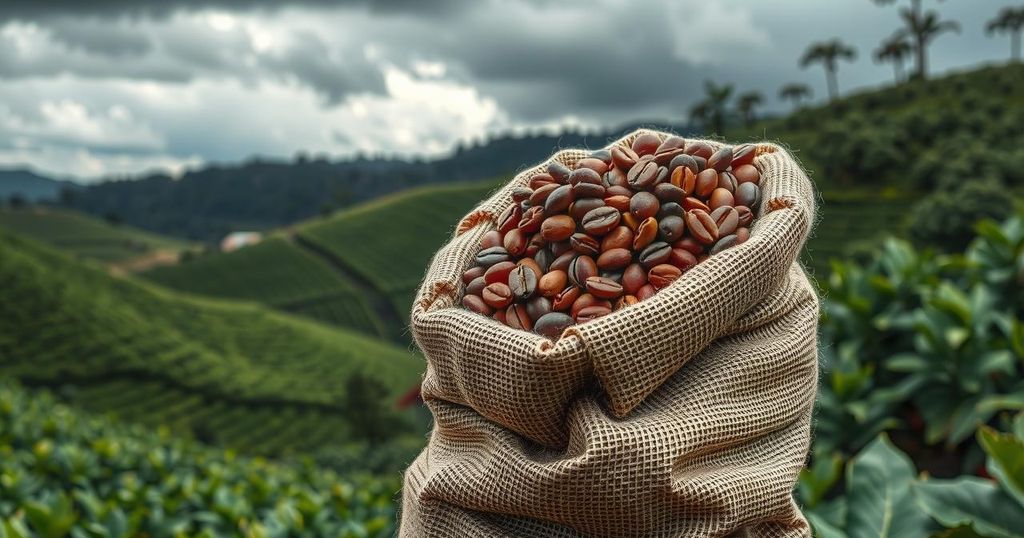Arabica Coffee Prices Surge Amid Weather Concerns in Brazil
Arabica coffee prices have reached a two-week high due to insufficient rainfall in Brazil, raising concerns over crop yields. Robusta coffee prices fell as inventories increased. Brazil is experiencing prolonged dry conditions, impacting both arabica and robusta coffee production. Despite some positive export figures, a widening global coffee surplus is anticipated, with mixed projections for future production.
Coffee prices exhibited a mixed performance as of today, with May arabica coffee reaching a two-week high, gaining 0.30 points (+0.08%). Meanwhile, May ICE robusta coffee decreased by 21 points (-0.38%). The surge in arabica prices is attributed to inadequate rainfall in Brazil, particularly in the Minas Gerais region, where only 30.8 mm of rain was recorded recently, representing 71% of the historical average.
The Brazilian cooperative Cooxupe indicated that rising temperatures and below-normal rainfall are anticipated to adversely impact coffee yields this year. Conversely, robusta coffee experienced a decline after witnessing a rise in ICE-monitored inventories, which reached a 1.5-week high of 4,336 lots, while arabica inventories decreased to a 3.5-week low of 782,648 bags.
Concerns regarding coffee supply are benefiting coffee prices further. Reports from Cecafe indicated that Brazil’s green coffee exports dropped by 12% year-on-year in February, totaling 3 million bags. Additionally, Brazil’s government agency, Conab, revised its forecast for the 2025/26 coffee crop, projecting a 4.4% year-on-year decline to a three-year low of 51.81 million bags.
In a contrary note, Marex Solutions highlighted the expectation of a coffee surplus in the 2025/26 season, widening to 1.2 million bags from a previous surplus of 200,000 bags in the 2024/25 season. On the robusta side, Vietnamese coffee exports rose by 6.6% year-on-year to 169,000 metric tons in February, potentially impacting prices negatively.
Prolonged dry conditions, exacerbated by El Nino, are causing long-term crop damage across South and Central America. Rainfall in Brazil has remained below average since April, affecting the flowering stage of coffee plants. Furthermore, Colombia’s coffee industry is gradually recovering from similar drought conditions affecting its production.
Robusta coffee prices are bolstered by reduced production in Vietnam, where drought has led to a 20% decrease in the 2023/24 crop year. Projections indicate a slight dip in robusta production for the upcoming 2024/25 marketing year. Notably, Vietnam’s coffee exports saw a 17.1% year-on-year reduction recently.
Conversely, reports of increased global coffee exports present a bearish outlook for prices. Conab disclosed a remarkable 28.8% year-on-year increase in Brazil’s coffee exports, while ICO indicated a 12.4% year-on-year decline in December global coffee exports.
The USDA’s biannual forecast presents a mixed bag for coffee prices, detailing an anticipated 4% increase in world coffee production for the 2024/25 marketing year. Yet, it forecasts a significant decline in ending stocks to the lowest level in 25 years. Furthermore, Volcafe has lowered Brazil’s 2025/26 arabica coffee production estimate due to the prolonged drought conditions, projecting a global deficit of arabica coffee.
In summary, arabica coffee prices are on the rise due to adverse weather conditions in Brazil, particularly insufficient rainfall affecting crop yields. Despite positive export trends, concerns about potential oversupply and global coffee production adjustments present a complex market scenario. As crop forecasts reflect declining production, particularly for Brazil and Vietnam, coffee prices remain under pressure from various influencing factors.
Original Source: www.nasdaq.com




Post Comment